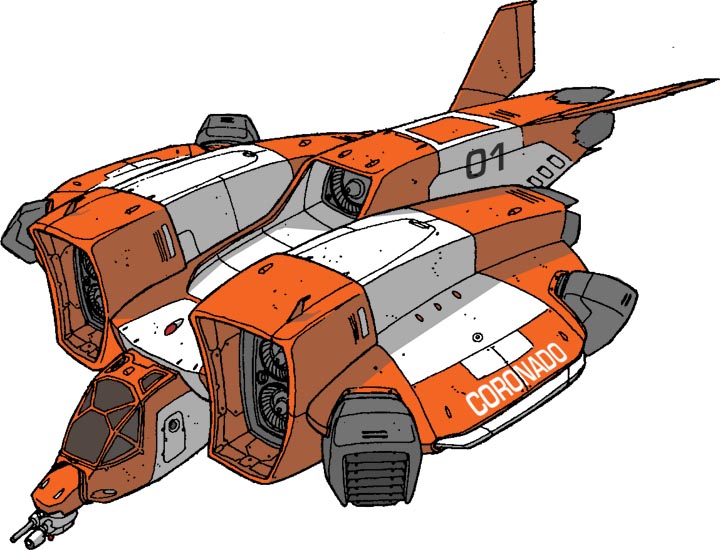
T-626-ESR Samaritan
Country of Origin: Banzaidyne Custom WorksOriginal art courtesy of Dream Pod 9 (© 1996 - , Dream Pod 9. All rights reserved; used with permission.)
Click on image to display larger version

|
T-626-ESR SamaritanCountry of Origin: Banzaidyne Custom WorksOriginal art courtesy of Dream Pod 9 (© 1996 - , Dream Pod 9. All rights reserved; used with permission.) Click on image to display larger version |
| Specifications | |
| Type: Emergency/search-and-rescue aircraft | Manufacturer: Northco / Pegasus Avionics, modifications by Banzaidyne Custom Works |
| Armor Material: Durasheet with alloy and ceramic | Armor Thickness: Average of 225mm |
| Length: 32.4 m | Wingspan: 27.2 m |
| Weight: 100,500 kg | Maximum Speed: 628 kph |
| Powerplant: 5 x jet turbines | Thrust: 1 x 1900 kg, 4 x 2400 kg |
| Description | |
| Size: 15 | Total Actions: 3 |
| Offense | |||||||||||||
| Weapon | Code | Arc | S | M | L | EX | Acc | FC | Dam | Qty | ROF | Special | Ammo |
| None fitted | |||||||||||||
| Defense | |
| Primary Movement: Flight 0/11/21 (630 kph) | Secondary Movement: Ground (Wheeled) 0/0 (0 kph) |
| Maneuver: -3 | Armor: 15 / 30 / 45 |
| Miscellaneous | |
| Crew: 4 (Pilot, Copilot, Sensor Officer, Communications Officer) | Deployment Range: 3500 km |
| Sensors: +2 / 3 km ground, 30 km air | Communications: +1 / 15 km ground, 150 km air |
| Perks: Airlift Winch (Rating 8, AUX), Aquatic Sensors (AUX), Autopilot (AUX), Cargo Bay (50 cubic meters), Chaff/Flare Dispensers (Rating 2, 15 shots, AUX), Geological Sensors (AUX), Life Support (Limited, AUX), Loudspeakers (powerful, AUX), Passenger Seating (16), Searchlight (swivel, 150 m range, AUX), Sick Bay (6 patients) | Flaws: Cannot Glide, Large Sensor Profile (Rating 2), Maximum Ceiling (10 km) |
| Defects: None | Lemon Dice: 3 |
| Notes |
|
Since its introduction, models of the T-626 Orca Gear transport has been adapted to fulfill a number of missions, and The Samaritan is no exception. At the request of Coronado's 1st Air Wing, Banzaidyne modified a standard Orca hull to create a remarkably capable emergency and search-and-rescue VTOL platform. The standard vehicle bay of the Orca is replaced by a well-equipped sickbay, allowing onboard medical staff to treat up to six patients at once. Additional seats were also added to accomodate up to 16 aid and medical specialists. The Samaritan's cargo bay is stocked with first aid packs, blankets, rations and water for distribution to disaster victims, and the belly of its hull was modified and reinforced to accept a winch capable of lifting most Gears in Coronado service. The sensor suite of The Samaritan is dramatically upgraded from the standard Orca. These upgrades include ground-penetrating radar and sonar, allowing the craft to scan for earthquake survivors who are buried under the rubble of buildings and to search for vehicles that have sunk underwater. These sensors are manned by a dedicated crewman, so the flight crew can concentrate on search patterns. The Samaritan retains the high armor and the chaff/flare dispensers of the standard Orca, but dispenses with the Orca's signature suppression features. This is seen as an asset, since this craft is intended to be noticed as much as possible. Likewise, The Samaritan sports a high-visiblity white and orange paint scheme for rapid visual detection. The craft also carries a set of powerful loudspeakers for the crew to make announcements while in the air, even if only to say "Help is on the way."
|